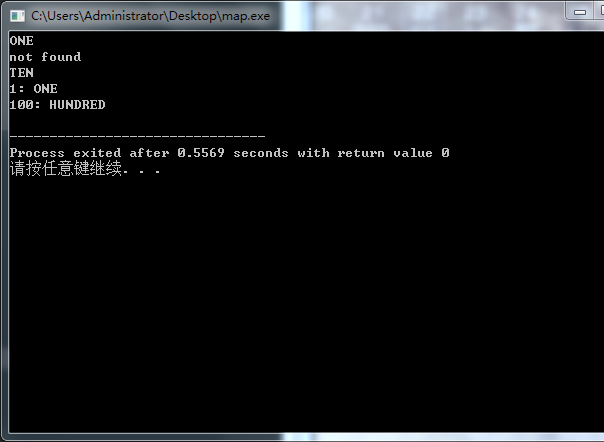本质上也用到了二叉搜索树,是维护键与键对应值的容器~
1 2 3 4 5 6 7 8 9 10 11 12 13 14 15 16 17 18 19 20 21 22 23 24 25 26 27 28 29 30 31 32 33 34 35 36 37 38 39 | #include<cstdio>#include<map>#include<cstring>#include<string>using namespace std;int main(){ //声明 first键,second值 map<int,const char*> m; //const char*字符型数组 //map<int,string> m; //插入元素写法1 m.insert(make_pair(1,"ONE")); m.insert(make_pair(10,"TEN")); //typedef pair<int,const char*> p; //m.insert(p(10,"TEN")); //插入元素写法2 m[100]="HUNDRED"; //查找元素写法1 map<int,const char*>::iterator it; it=m.find(1); puts(it->second);//迭代器相当于指针而非结构体 it=m.find(2); if(it==m.end()) puts("not found"); else puts(it->second); //查找元素写法2 puts(m[10]); //puts(m[11]); //删除元素 m.erase(10); //遍历所有元素 for(it=m.begin();it!=m.end();++it) printf("%d: %s\n",it->first,it->second); return 0;} |
输出结果:
上述注释掉的代码或多或少都有些问题,所以尽量还是用程序中的写法吧:
- 定义string类型需要头文件#include<string>,注意只有#include<cstring>是不行的
- int键对应字符串值时,最好用字符型数组,string类型编译没有通过 。注意字符型数组表示为const char*
-
UPD:值可以是string型 - 用pair时不需头文件定义。插入时make_pair()即可。定义一个pair的写法运行时发生错误
-
查找元素的第二种写法,即直接puts(map[i]) 若运行注释掉的语句 输出如下:

UPD:
- 另外一些基本操作:
1 2 3 4 5 6 7 8 9 10 11 12 | cout<<"map 的 max_size 的值:"<<studentMessage.max_size()<<endl;cout<<"map 的 size 的值:"<<studentMessage.size()<<endl;studentMessage.clear();if(studentMessage.empty()){ cout<<"The map is Empty !!"<<endl;}else{ cout<<"The map is not Empty !!"<<endl;} |
- 查找:
find(key)可确定查找元素的位置
count(key)
因为map中的值不允许重复,所以一个值只能出现一次,
这说明count的返回值就只能是0或1,即可完成查找操作
但是用count来完成查找并不是最优的选择,因为原来的本意是用count来完成计数的,(这在vector等序列式容器中非常好用,而map中之所以有这个count函数,就是为了STL提供统一的接口,这样说来map中的upper_bound和lower_bound,equel_range等函数组合起来也可完成查找功能)

 评论 (0)
评论 (0)